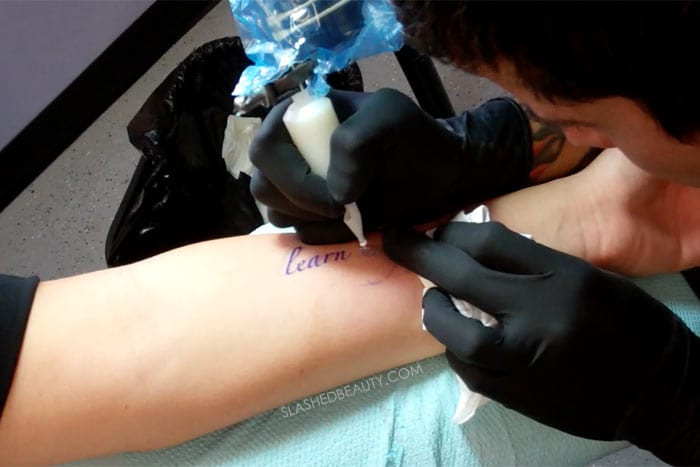White ink tattoos offer a unique aesthetic, but how do white ink tattoos age? At tattooat.com, we’ll explore the longevity, fading process, and other factors influencing the appearance of white ink tattoos over time, helping you make informed decisions about your body art. Whether you are looking for subtle skin art, fine line tattoo, or unique tattoo experience, understanding the aging process is crucial for satisfaction with your white ink tattoo.
1. What Are White Ink Tattoos?
White ink tattoos use specialized white tattoo ink instead of traditional colored inks. These tattoos are favored for their subtle appearance, creating a delicate and understated look on the skin. White ink is often used for minimalist designs, geometric patterns, or as highlights in combination with other colors. Unlike traditional tattoos that make a bold statement, white ink tattoos offer a more discreet form of self-expression. These are popular among those who desire body art that is less conspicuous, offering a blend of personal style and subtlety. The choice of white ink allows for intricate detailing that appears almost like a natural part of the skin, especially as it ages and softens further.
1.1. How Do White Ink Tattoos Differ from Traditional Tattoos?
White ink tattoos differ significantly from traditional tattoos in several key aspects:
- Visibility: Traditional tattoos are designed to be highly visible and make a bold statement, while white ink tattoos are much more subtle.
- Ink Composition: Traditional tattoo inks contain heavy pigments for lasting color. White ink has a different formulation, affecting its longevity and how it interacts with the skin.
- Application: White ink can be more challenging to apply than traditional inks, requiring experienced artists to prevent issues like ink mixing with the stencil or uneven application.
- Fading: White ink fades differently, often blending with the skin tone over time, which can be a pro or con depending on the wearer’s preference.
- Skin Tone Interaction: The appearance of white ink tattoos can vary significantly depending on skin tone, while traditional tattoos maintain their color integrity better across different complexions.
These differences make white ink tattoos a unique choice, appealing to those seeking a less conventional form of body art.
1.2. Why Choose a White Ink Tattoo?
Choosing a white ink tattoo comes with several unique appeals:
- Subtlety: White ink tattoos are incredibly subtle, making them perfect for individuals who want a tattoo that isn’t immediately noticeable.
- Uniqueness: They stand out due to their uncommon nature; many people may have never seen a white ink tattoo before.
- Discreetness: They can be easily concealed, making them suitable for professional environments where visible tattoos may not be preferred.
- Personal Meaning: Given their subtlety, white ink tattoos often hold deep personal significance, acting as a private reminder or statement.
- Minimalist Aesthetic: They align well with minimalist fashion and lifestyle preferences, offering a clean and understated look.
- Fading as a Pro: For some, the fading nature of white ink is an advantage, providing a low-commitment option for those unsure about long-term tattoo permanence.
- Highlighting: White ink can be used to add highlights to existing tattoos.
For more inspiration and ideas, visit tattooat.com to explore a range of white ink tattoo designs.
2. The Aging Process of White Ink Tattoos
The aging process of white ink tattoos is distinct and varies significantly from traditional tattoos. Understanding this process is vital for anyone considering this type of tattoo.
2.1. How Does White Ink Fade Over Time?
White ink tattoos tend to fade and change appearance much more rapidly than traditional tattoos. Several factors contribute to this:
- Ink Density: White ink typically has a lower pigment density compared to colored inks, leading to quicker absorption and dispersion within the skin.
- Skin Tone: The contrast between white ink and the natural skin tone affects how visible the tattoo remains over time. In darker skin tones, the fading can be more noticeable as the ink blends with the melanin.
- Sun Exposure: Exposure to UV rays can cause the ink to break down faster.
- Skin Hydration: The level of skin hydration also plays a role. Well-hydrated skin can retain the ink better.
Initially, the tattoo may appear bright, but over months and years, it typically softens and fades.
2.2. What Factors Influence the Longevity of White Ink Tattoos?
Several factors influence the longevity of white ink tattoos:
- Skin Tone: White ink tattoos typically last longer on pale skin tones because there is less melanin affecting the ink.
- Sun Exposure: Excessive sun exposure without protection can accelerate fading. Regular use of sunscreen can help preserve the tattoo.
- Ink Quality: The quality of the white ink used significantly impacts its longevity. High-quality inks designed for tattooing tend to last longer.
- Artist Technique: The skill and technique of the tattoo artist are crucial. Proper depth and application ensure the ink is deposited effectively in the skin.
- Aftercare: Following proper aftercare instructions, including keeping the area clean and moisturized, can enhance the tattoo’s longevity.
- Location on the Body: Tattoos on areas with more friction or movement, such as hands or feet, may fade faster than those on less mobile areas.
- Individual Skin Characteristics: Factors such as skin type, hydration levels, and overall skin health can affect how well the ink is retained.
- Lifestyle: Habits like smoking and excessive alcohol consumption can impact skin health and ink retention.
2.3. How Does Skin Tone Affect White Ink Tattoos?
Skin tone significantly affects the appearance and longevity of white ink tattoos. Here’s how:
- Lighter Skin Tones: White ink tattoos tend to show up better and last longer on lighter skin because there is less melanin to interfere with the ink’s visibility. The contrast is higher, making the tattoo more noticeable.
- Darker Skin Tones: On darker skin, white ink tattoos may appear more subtle and can sometimes take on a yellowish or beige hue as they heal. They may also fade more quickly due to the higher melanin content, which can cause the ink to blend with the skin tone.
- Mixed Skin Tones: Individuals with mixed skin tones may experience varied results depending on the specific shade and melanin distribution in the tattooed area.
It is essential to consult with an experienced tattoo artist who can assess your skin tone and provide realistic expectations about how the white ink will appear and age.
 White ink tattoo on the inner arm
White ink tattoo on the inner arm
Alt text: Fresh white ink tattoo on a fair-skinned inner arm, showcasing its initial subtle and clean appearance.
3. Potential Issues with Aging White Ink Tattoos
As white ink tattoos age, several potential issues can arise, affecting their overall appearance and satisfaction.
3.1. Yellowing or Discoloration
One common issue with aging white ink tattoos is yellowing or discoloration. This can occur due to:
- Sun Exposure: UV rays can cause the white ink to break down, leading to a yellowish or beige tint.
- Ink Quality: Lower-quality inks may contain impurities that cause discoloration over time.
- Skin Oils: Natural skin oils and environmental factors can interact with the ink, causing it to change color.
- Tanning: Tanning can affect the color of the tattoo.
To minimize yellowing, protect the tattoo from the sun with sunscreen and consider using high-quality tattoo inks.
3.2. Fading and Blurring
Fading and blurring are typical issues with white ink tattoos as they age. These problems are often due to:
- Ink Migration: Over time, the ink particles can migrate within the skin, causing the lines to blur.
- Natural Exfoliation: The skin naturally exfoliates, and this process can gradually remove ink particles, leading to fading.
- Inconsistent Application: Uneven ink application by the artist can result in patchy fading.
Proper aftercare and choosing an experienced artist can help reduce these issues.
3.3. Raised or Scarred Appearance
In some cases, white ink tattoos can develop a raised or scarred appearance. This can happen if:
- Excessive Trauma: The tattooing process can cause trauma to the skin, leading to scar tissue formation.
- Ink Consistency: White ink tends to have a thicker consistency, which can sometimes cause a raised effect, particularly if applied too deeply.
- Allergic Reaction: In rare cases, an allergic reaction to the ink can cause inflammation and scarring.
If you notice a raised or scarred appearance, consult with a dermatologist or tattoo artist for advice.
4. Caring for Your White Ink Tattoo to Ensure Longevity
Proper care is essential to prolong the life and appearance of your white ink tattoo.
4.1. Immediate Aftercare Tips
Immediate aftercare is crucial for the healing and longevity of a white ink tattoo:
- Keep it Clean: Gently wash the tattooed area with mild, fragrance-free soap and water 2-3 times a day.
- Moisturize: Apply a thin layer of a tattoo-specific aftercare lotion or a fragrance-free moisturizer to keep the skin hydrated.
- Avoid Sun Exposure: Keep the tattoo out of direct sunlight during the healing process.
- Wear Loose Clothing: Avoid tight clothing that can rub against the tattoo and cause irritation.
- Avoid Soaking: Do not soak the tattoo in water (e.g., swimming, baths) until it is fully healed.
- Do Not Pick or Scratch: Avoid picking or scratching the tattoo, as this can lead to infection or scarring.
Following these steps will help ensure proper healing and reduce the risk of complications.
4.2. Long-Term Maintenance
Long-term maintenance is key to keeping your white ink tattoo looking its best:
- Sun Protection: Apply a high SPF sunscreen to the tattoo whenever you are exposed to the sun.
- Moisturize Regularly: Keep the skin moisturized to prevent it from drying out, which can cause the tattoo to fade more quickly.
- Avoid Harsh Chemicals: Avoid using harsh soaps, exfoliants, or chemicals on the tattooed area.
- Stay Hydrated: Drink plenty of water to keep your skin hydrated from the inside out.
- Consider Touch-Ups: Depending on how well your tattoo ages, you may want to consider touch-ups every few years to refresh the ink.
4.3. Products to Use and Avoid
Choosing the right products can significantly impact the longevity of your white ink tattoo:
| Product Type | Recommended | Products to Avoid |
|---|---|---|
| Soaps | Mild, fragrance-free, hypoallergenic soaps | Soaps with harsh chemicals, fragrances, or dyes |
| Moisturizers | Tattoo-specific aftercare lotions, fragrance-free moisturizers (e.g., Aquaphor, Cetaphil) | Heavy, greasy lotions or petroleum-based products (can clog pores) |
| Sunscreen | High SPF (30 or higher), broad-spectrum sunscreen | Sunscreens with alcohol or fragrances |
| Exfoliants | Gentle, enzyme-based exfoliants (use sparingly and after the tattoo is fully healed) | Harsh scrubs, chemical peels, or abrasive exfoliants |
| Clothing | Loose-fitting, breathable fabrics (e.g., cotton) | Tight, restrictive clothing that can rub against the tattoo |
| Other Products | Tattoo balms with natural ingredients (e.g., shea butter, coconut oil) | Products containing alcohol, parabens, or sulfates |
Using the right products and avoiding harmful ones can help maintain the vibrancy and clarity of your white ink tattoo over time.
5. Choosing the Right Tattoo Artist for White Ink
Selecting the right tattoo artist is paramount for a successful white ink tattoo.
5.1. Importance of Experience with White Ink
Experience with white ink is crucial because:
- Application Technique: White ink has a thicker consistency, requiring a different application technique than traditional inks. An experienced artist knows how to work with this texture to achieve clean lines.
- Preventing Staining: Inexperienced artists may inadvertently mix stencil ink with the white ink, resulting in a dingy gray color.
- Understanding Fading: An artist experienced with white ink can provide realistic expectations about how the tattoo will fade based on your skin tone and other factors.
- Knowing Ink Properties: They understand how different white inks behave and can choose the best one for your desired outcome.
5.2. How to Find a Qualified Artist
Finding a qualified artist for white ink tattoos involves several steps:
- Portfolio Review: Look at the artist’s portfolio to see examples of their white ink work. Pay attention to how well the tattoos have healed and aged.
- Consultation: Schedule a consultation to discuss your design and ask about their experience with white ink.
- Read Reviews: Check online reviews and testimonials to see what other clients have to say about their experience.
- Ask for Recommendations: Ask friends or online communities for recommendations of artists who specialize in white ink tattoos.
- Check Credentials: Ensure the artist is licensed and works in a reputable studio with proper hygiene standards.
5.3. Questions to Ask During Consultation
During your consultation, ask the artist:
- “How many white ink tattoos have you done?”
- “Can I see healed examples of your white ink work?”
- “What type of white ink do you use, and why?”
- “How do you ensure the stencil ink doesn’t mix with the white ink?”
- “What are your recommendations for aftercare?”
- “What can I expect in terms of fading and longevity?”
- “Do you offer touch-ups, and what is the cost?”
Their answers will provide valuable insights into their expertise and help you make an informed decision.
 White ink tattoo artist working on a client
White ink tattoo artist working on a client
Alt text: Tattoo artist carefully applying white ink over a stencil, highlighting the precision required for this delicate art form.
6. White Ink Tattoo Designs and Placement
Choosing the right design and placement can significantly impact the appearance and longevity of your white ink tattoo.
6.1. Best Design Options for White Ink Tattoos
The best design options for white ink tattoos often include:
- Minimalist Designs: Simple lines, geometric shapes, and small symbols work well with the subtlety of white ink.
- Lace or Ornamental Patterns: Delicate lace or ornamental patterns can create a beautiful, subtle effect.
- Lettering: Small, elegant lettering can be a meaningful and discreet choice.
- Highlights: White ink can be used to add highlights and dimension to existing colored tattoos.
- Geometric Shapes: From simple lines to intricate shapes, white ink can make your skin pop.
Avoid designs that are too intricate or have large solid areas, as these may not age well with white ink.
6.2. Ideal Body Placement
Ideal body placements for white ink tattoos include areas with:
- Less Sun Exposure: Areas that are typically covered by clothing, such as the back, chest, or inner arms, are ideal because they are less exposed to the sun.
- Stable Skin: Areas with stable skin that doesn’t stretch or move excessively, such as the upper back or collarbone, can help the tattoo retain its shape.
- Good Visibility: Placement should allow for visibility of the tattoo in appropriate settings.
6.3. Designs to Avoid
Certain designs and placements are less suitable for white ink tattoos:
- Large Solid Areas: Large areas of solid white ink can fade unevenly and may develop a patchy appearance.
- High-Friction Areas: Areas that experience a lot of friction, such as hands, feet, or joints, can cause the tattoo to fade more quickly.
- Areas with High Sun Exposure: Areas that are frequently exposed to the sun, such as the face, neck, or lower arms, are not ideal for white ink tattoos due to the risk of fading and discoloration.
7. Alternatives to White Ink Tattoos
If you’re hesitant about getting a white ink tattoo due to its potential issues, several alternatives offer similar aesthetics.
7.1. UV Tattoos
UV tattoos, also known as blacklight tattoos, use ink that is nearly invisible under normal light but glows under ultraviolet (UV) light. These can provide a subtle look in everyday settings while offering a unique visual effect in specific environments.
7.2. Light-Colored Inks
Light-colored inks, such as pastels or light grays, can provide a more visible but still subtle alternative to white ink. These colors tend to last longer and are less prone to yellowing.
7.3. Scarification
Scarification involves creating designs by cutting or etching the skin. This can produce a subtle, textured effect that is similar to a white ink tattoo, without the use of ink.
7.4. Henna Tattoos
Henna tattoos are temporary and made from a natural dye. They can create intricate designs that last for a few weeks, providing a low-commitment alternative to permanent tattoos.
8. Correcting or Removing White Ink Tattoos
If you’re unhappy with your white ink tattoo, options are available for correction or removal.
8.1. Touch-Ups
Touch-ups can refresh a faded white ink tattoo and improve its appearance. This involves adding more ink to the existing design to restore its vibrancy and clarity.
8.2. Cover-Ups
A cover-up involves tattooing a new design over the existing white ink tattoo. This is a good option if you want to completely change the appearance of the tattoo. However, because white ink is difficult to cover, you may need to choose a darker, more opaque ink for the cover-up design.
8.3. Laser Removal
Laser tattoo removal is an effective method for removing white ink tattoos. The laser breaks down the ink particles, which are then naturally eliminated by the body. Multiple sessions are typically required for complete removal.
9. Real-Life Experiences with White Ink Tattoos
Hearing from others who have white ink tattoos can provide valuable insights into what to expect.
9.1. Personal Anecdotes
Many individuals with white ink tattoos share similar experiences:
- Initial Excitement: They often love the subtle, unique look of their fresh white ink tattoo.
- Fading Concerns: Many notice significant fading within a few years, leading to disappointment.
- Maintenance Efforts: Those who diligently protect their tattoos from the sun and moisturize regularly tend to have better results.
- Regret or Acceptance: Some regret their decision due to the fading, while others embrace the tattoo’s evolving appearance.
- Scarring: Some people experienced scarring and keloid formation.
These personal stories highlight the importance of realistic expectations and proper care.
9.2. Expert Opinions
Tattoo artists and dermatologists offer valuable insights on white ink tattoos:
- Artist Perspective: Tattoo artists emphasize the importance of choosing an experienced artist who specializes in white ink. They also stress the need for proper aftercare to maximize longevity.
- Dermatologist View: Dermatologists advise clients to protect their tattoos from the sun and be aware of the risk of allergic reactions or scarring. They also recommend laser removal as an effective option for those who are unhappy with their tattoos.
- Portland State University’s Art Department: According to research from Portland State University’s Art Department, in July 2025, white ink tattoos fade faster on areas of the body exposed to the sun.
10. FAQ About White Ink Tattoos
Here are some frequently asked questions about white ink tattoos:
10.1. Are White Ink Tattoos More Painful?
No, white ink tattoos are not inherently more painful than traditional tattoos. The level of pain depends more on the individual’s pain tolerance and the tattoo’s placement than the color of the ink.
10.2. Do White Ink Tattoos Glow in the Dark?
No, white ink tattoos do not glow in the dark. This is a common misconception. If you want a tattoo that glows under blacklight, you need to use UV ink, which is different from white ink.
10.3. How Much Do White Ink Tattoos Cost?
The cost of a white ink tattoo is similar to that of a traditional tattoo and depends on factors such as the size, complexity, and the artist’s rates.
10.4. Can White Ink Tattoos Be Used on Dark Skin?
Yes, white ink tattoos can be used on dark skin, but they may not be as visible and may fade more quickly due to the higher melanin content.
10.5. What Happens if I Tan with a White Ink Tattoo?
If you tan with a white ink tattoo, the contrast between the ink and your skin will decrease, making the tattoo less visible. The ink may also take on a yellowish or beige hue.
10.6. Are White Ink Tattoos More Likely to Get Infected?
White ink tattoos are not inherently more likely to get infected than traditional tattoos. The risk of infection depends more on proper hygiene and aftercare practices.
10.7. How Long Do White Ink Tattoos Last?
White ink tattoos typically last for a few years, but they tend to fade more quickly than traditional tattoos.
10.8. Can I Get a White Ink Tattoo Removed?
Yes, you can get a white ink tattoo removed with laser tattoo removal. Multiple sessions are usually required for complete removal.
10.9. Are White Ink Tattoos More Likely to Scar?
White ink tattoos may be slightly more prone to scarring due to the thicker consistency of the ink and the potential for the artist to apply it too deeply.
10.10. Are There Any Risks Associated with White Ink Tattoos?
Yes, there are some risks associated with white ink tattoos, including allergic reactions, scarring, and fading.
White ink tattoos offer a unique and subtle form of self-expression, but they require careful consideration and proper care. By understanding the aging process, choosing a qualified artist, and following the right aftercare practices, you can enjoy your white ink tattoo for years to come.
Ready to explore the world of tattoos? Visit tattooat.com today for inspiration, artist recommendations, and expert advice. Discover designs that resonate with you, find talented artists in your area, and dive into a wealth of knowledge about tattoo culture and techniques. Let tattooat.com be your guide to expressing yourself through body art!
Address: 1825 SW Broadway, Portland, OR 97201, United States
Phone: +1 (503) 725-3000
Website: tattooat.com

